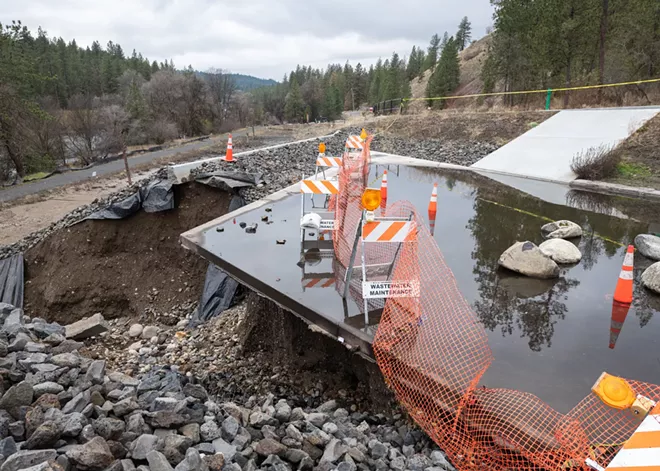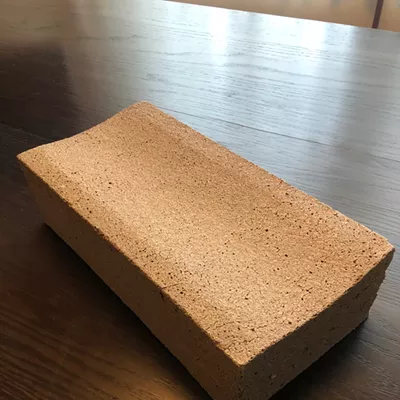
Under a steady drizzle of rain, Spokane city officials gathered with camera crews, state representatives and beloved river mascot Ribby the Redband Trout on Nov. 4 to receive the Governor's Smart Communities Award for the new Cochran Basin stormwater improvement projects in north Spokane.
Five Cochran Basin stormwater improvement projects have been in the works since 2017. In total, they have cost about $25.5 million, most of which came from the Washington state Department of Ecology.
The award from the governor was a little premature, since the projects aren't scheduled to become fully functional until spring 2025.
The work has centered on the TJ Meenach Bridge and Downriver Park, low areas where water from 5,000 acres of north Spokane naturally collects on its way to the Spokane River. The projects aim to keep stormwater pollutants — like car oil and pesticides — out of the river by catching, trapping or treating runoff from rain and melting snow.
A little over a week after the award ceremony, one of those projects faced its first failure.
An earthen wall supporting a stormwater catchment site next to the TJ Meenach Bridge partially collapsed on Nov. 13. The catchment site was one of the projects included in the $3.6 million TJ Meenach Drive street reconstruction project.
Some sediment and untreated stormwater was caught and collected by the new swales — specially bioengineered reservoirs — below the catchment. But some made it into the Spokane River by about 12:50 pm that day, temporarily increasing the river's turbidity in the affected area, says Kirstin Davis, communications manager for Spokane Public Works.
Increased turbidity (how many particles are in a body of water) damages aquatic ecosystems by introducing pollutants and decreasing oxygen levels.
The small collapse occurred because an unusual amount of rain in November overwhelmed a system that isn't totally online yet, Davis says.
"It's kinda like the house is built, but we haven't turned on the furnace and it's not livable yet," she says.
Crews haven't been able to start fixing the wall because of continued rain, which measured well over 4 inches by the end of the month.
"When it first happened, we had crews getting down in there and trying to, for a lack of a better term, 'plug the hole' with sandbags," Davis says. "But the pressure was so high that the sandbags just sucked right through. So it just wasn't gonna be possible to do anything, and we certainly didn't want to start excavating when things are already compromised."
Since the ground will freeze over during the winter, true repairs won't be made until spring at the earliest, Davis says.
WHEN IT RAINS...
Spokane got 1.86 inches of rain in the first 13 days of November.
That's an inch more than the average amount of rainfall for the first two weeks of November.
An inch might not seem like all that much. But an inch of rain over the entire 5,000-acre Cochran Basin drainage area, which stretches from Market Street and Francis Avenue to the TJ Meenach Bridge, adds up.
In fact, it's nearly 136 million more gallons of runoff than usual, according to calculations by the U.S. Geological Survey. That means more than 200 million gallons of stormwater were surging through north Spokane's underground stormwater system between Nov. 1 and Nov. 13.
The beating heart of the new Cochran Basin stormwater projects is supposed to be a pump station at the top of the TJ Meenach hill. Once the station is operational, it'll be able to triage large amounts of runoff into three separate runoff systems, Davis says.
"It's the brain," she says. "It can be monitored at all times, so when our engineers are watching the flow, they are able to control what's happening based on either what's coming through or what is forecasted."
The three different places for the water to go are the treatment ponds at the new Downriver Disc Golf Course, the catchment and swales next to the bridge, and, if worse comes to worst, a combined sewer overflow outfall pipe that allows untreated water to discharge straight into the river, Davis says.
Outfall pipes used to be the only discharge option for stormwater, says Andy Dunau, the former executive director of the Spokane River Forum. Originally, Spokane had about 130 combined sewer and stormwater outfall drains, similar to other older cities. But as water quality standards go up, outfall drains around the country are being replaced.
...IT POURS
On Nov. 1, the brain of the Cochran Basin stormwater system ran and passed its first test. But the pumps were not intended to fully come online until next spring, Davis says. The collapse on Nov. 13 interrupted another test that was planned for two days later.
After the first test, stormwater was only pouring into the overflow catchment between the bridge and the Downriver Park parking lot.
The catchment is a shallow basin with a cement bottom and soil walls reinforced by rocks. It's fed by a drain pipe,and has a handful of large boulders spaced out in front of the pipe to slow the outflowing water.
The catchment funnels water toward a channel carved into the earthen wall. Water is supposed to flow down that channel and into three large depressions in the earth below, called swales.
These swales are filled with native plants, plus bioengineered soil that is especially good at filtering out pollutants. As the water sits in these swales, it is purified as it percolates through the soil, and eventually becomes safe and healthy groundwater.
That's the design, at least. But with the unexpected amount of water, the small channel designed to guide the drainage wasn't strong enough. Water eventually forged its own, much larger path down the small hillside, dragging earth along with it.
Plenty of that water and dirt did deposit in the swales as intended, which Davis says is a major win for the system. But millions of gallons of muddy water poured over the riverbank.
"It's obviously disappointing that it happened and it's a setback, but [the system] also did what it was supposed to do in spite of it not being done," she says. "It could've been much, much worse."
The new Cochran Basin projects are funded by and permitted through the state Department of Ecology. When the collapse happened, the city notified Ecology and submitted the required incident reports, says Colleen Keltz, communications manager for Ecology's water quality department. Ecology staff visited the site of the breach during the last week of November and are working with the city to schedule repairs and review water quality samples.
NEXT STEPS
The city won't know how much it will cost to repair the hillside until staff decide how to repair it.
"We need time to look at the design and see if we need to change it," Davis says.
Engineers may decide to use different materials or design strategies to make the catchment area stronger than before, even though Davis says this particular situation would theoretically never happen again once the pump system is operational.
Moody spring weather could lengthen the repair process as it would any other construction, but runoff should not be an issue this spring. The pump system should be in place by the heavy runoff season to completely divert stormwater away from the catchment area until repairs are complete, Davis says.
Corrective construction could block the main entrance to the Downriver Park parking lot. But if that's the case, the city would adjust access to parking and maintain access to the river, which is a very popular recreation spot during the warm months. ♦





















